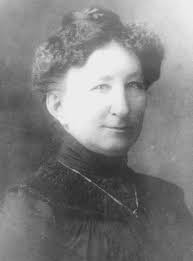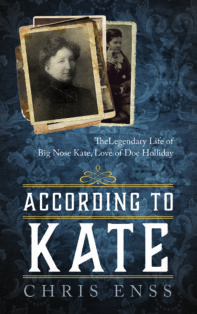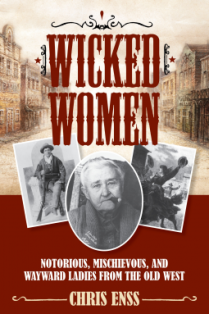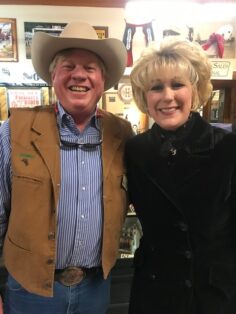1859 – One of the oldest known copies of the Bible, “The Codex Sinaiticus” (Sinai Bible), is seen in Egypt by Constantin von Tischendorf who takes the manuscript home with him.
Journal Notes
The Girl from Hungary
Enter now to win a copy of
According to Kate:
The Legendary Life of Big Nose Kate, Love of Doc Holliday

According to Kate: The Legendary Life of Big Nose Kate, Love of Doc Holliday is writer Chris Enss’ latest exploration of the lives of women who shaped the West. Mary Kate Cummings, known as Big Nose Kate among many other aliases, claimed to witness the shoot-out at the OK Corral as well as other famous moments in history alongside her longtime paramour, the dentist-turned-gunfighter John Henry “Doc” Holliday. For years, Cummings collected letters, her own written musings on her life of adventure, and her accounts of the men she knew and the events she claimed to have witnessed. She always hoped that a publisher would pay her to tell the story of her life — but no book emerged while she was alive. In this biography, Enss delves into Cummings’ archives, allowing her version of events to shine.
Big Sky Journal

The Legendary Life of Big Nose Kate
Enter now to win a copy of
According to Kate:
The Legendary Life of Big Nose Kate, Love of Doc Holliday

Doc Holliday’s paramour Kate Elder could never get a publisher to give her the big bucks she demanded to tell the story of her life, but that didn’t mean she didn’t collect material she wanted to use in a biography. Over the fifty years Mary Kate Cummings-Elder, alias Big Nose Kate, traversed the West she saved letters from her family, musings she had written about her love interests, and life with the notorious John Henry Holliday. Using rare, never-before published material Big Nose Kate stockpiled in anticipation of writing the tale of her days on the Wild Frontier, the definitive book about the famous soiled dove has finally been told.
Kate claims to have witnessed the Gunfight at the OK Corral and exchanged words with the likes of Wyatt Earp and Josephine Marcus. There’s no doubt she embellished her adventures, but that doesn’t take away from their historical importance. She was a controversial figure in a rough and rowdy territory. What she witnessed, the lifestyle she led, and the influential western people she met are fascinating and represent a time much romanticized.
Wicked Women
Enter now to win a copy of
Wicked Women:
Notorious, Mischievous, and Wayward Women of the Old West

In 1849, women of easy virtue found wicked lives west of the Mississippi when they followed fortune hunters seeking gold and land in an unsettled territory. Prostitutes and female gamblers hoped to capitalize on the vices of the intrepid pioneers.
More than half of the working women in the California during the 1850s were prostitutes. At that time, madams – those women who owned, managed, and maintained brothels – were generally the only women out west who appeared to be in control of their own destinies. For that reason alone, the prospect of a career in the “oldest profession” – at least at the outset – must have seemed promising.
Often referred to as “sporting women” and soiled doves,” prostitutes mostly ranged in age from seventeen to twenty-five, although girls as young as fourteen were sometimes hired. Women over twenty-eight years of age were generally considered too old to be prostitutes.
Rarely, if ever, did working women use their real names. In order to avoid trouble with the law as they traveled from town to town, and to protect their true identities, many of these women adopted colorful new handles like Contrary Mary, Little Gold Dollar, Lazy Kate, and Honolulu Nell. The vicinities where their businesses were located were also given distinctive names. Bordellos and parlor houses typically thrived in that part of the city known as “the half world,” “the badlands,” “the tenderloin,” “the twilight zone,” or the red-light district.”
The term “red-light district” originated in Kansas. As a way of discouraging would-be intruders and brazen railroad workers around Dodge City began hanging their red brakemen’s lanterns outside their doors as signal that they were in the company of a lady of the evening. The colorful custom was quickly adopted by many ladies and their madams.
Generally speaking, a prostitute’s class was determined by her location and her clientele. High-priced prostitutes plied their trade in parlor houses. These immense, beautiful homes were well furnished and lavishly decorated. The women who worked at such posh houses were impeccably dressed, pampered by personal maids, and protected by the ambitious madams who managed the business. In general, parlor houses were very profitable. Madams kept repeat customers interested by importing women from France, Russia, England, and the East Coast of the United States. These ladies could earn more than $25 a night. The madams received a substantial portion of the proceeds, which were often used to improve the parlor house or to purchase similar houses.
The lifestyle was, without a doubt, a dangerous one, and many women despised being a part of the underworld profession. As Nebraska madam and prostitute Josie Washburn noted in 1896: “We are there because we must have bread. The man is there because he must have pleasure; he has no other necessity for being there; true if we were not there the men would not come. But we are not permitted to be anywhere else.”
Entertaining numerous men often resulted in assault, unwanted pregnancies, venereal disease, and even death. Some prostitutes escaped the hell of the trade by committing suicide. Some drank themselves to death; others overdosed on laudanum. Botched abortions, syphilis, and other diseases claimed many of their lives as well.
In the late 1860s, a concern for the physical condition of prostitutes – and moreover, for the effect their poor health was having on the community at large – was finally addressed. Government officials, alerted to the spread of infectious illnesses, decided to take action against women of ill repute. At a public meeting in New York City, a bill was introduced that was aimed at curtailing the activities of prostitutes who did not pass health exams. The goal of the bill was to stop the advance of what morally upright citizens termed the “social evil.”
To learn more about the soiled doves of the American frontier read
Wicked Women:
Notorious, Mischievous, and Wayward Ladies of the Old West
Comedy in Prescott

Last week at this time I was manning an author’s table at Art of the Cowgirl in Queen Creek, Arizona. The night before I was in Prescott. I’d been invited to give a presentation at the Western Heritage Center and it was a wonderful experience. In addition to meeting my dear friends Kat and Larry Martin at the event and staying the night at their place, I had an opportunity to meet some of the most kind and generous people at the museum. Prior to giving lectures about women of the American frontier, I was a standup comic. I worked my way through college doing standup at a strip club. Don’t ask me why they needed a comic at a strip club. I have no idea who thought that would work. But it did. Not a night went by that I didn’t hear, “Hey, get those naked women off the stage and bring up a comedian.” And then I would come out.
The good people of Prescott allowed me to work a few bits of comedy into my talk about the Old West. It was a grand time and I was grateful for the opportunity. True West magazine’s senior editor Stuart Rosebrook was instrumental in gaining the Western Heritage Center invite. Rosebrook is one of those people I count on for sound advice when it comes to the subject matters I tackle in the books I write. Had it not been for him I probably wouldn’t have written According to Kate: The Legendary Life of Big Nose Kate, Love of Doc Holliday nor would I have agreed to write Zoe Tilghman’s tale. There are a lot of so-called historians out there who don’t want you to write on certain subjects and they aren’t shy about letting you know. I wish everyone had someone in their corner like Stuart Rosebrook. And I wish everyone could travel to Prescott and meet the fine people who support the Western Heritage Center. What a time I had!
Hospice of the Foothills Event
The Widowed Ones Wins the PenCraft Book Awards
Deadwood’s Madam Dumont
Enter now to win an advanced copy of
An Open Secret: The Story of Deadwood’s Most Notorious Bordellos

Historians believe the scandalous Eleanora Dumont was one of the first madams to arrive in Deadwood Gulch in 1876. Her time in the Black Hills was brief. She was in her late forties, and much of her life as a prostitute and gambler had already been lived by the time she traveled to Deadwood. “Madame Mustache,” as she was also known, stayed in town long enough to fleece a few residents at the faro tables and spend an evening or two with curious men who knew of her reputation. Three years after making her way to the Dakota Territories, Eleanora was living in a gold mining town in California and reminiscing about life in Deadwood.
A pair of miners squinted into the early morning sky as they rode from the gold town of Bodie, California, toward their claim. Shafts of light poked through scattered clouds a few miles ahead on the rocky road. In the near distance, the men spotted what looked like a bundle of clothing lying just out of reach of the sun’s tentacles. They speculated that some prospector must have lost his gear riding through the area, but, as they approached the item, it was clear that it was not simply a stray pack. A woman’s body lay drawn in a fetal position, dead. The curious miners dismounted and hurried to the unfortunate soul.
The vacant eyes that stared up at the men were those of the famed Eleanora Dumont, the “Blackjack Queen of the Northern Mines.” An empty bottle of poison rested near her lifeless frame, and her dusty face was streaked with dried tears. One of the miners covered her with a blanket from his bedroll while the other eyed the vultures circling overhead.
Misfortune and a broken heart led to the fifty-year-old Dumont’s downfall. At one time she had been the toast of the gold rush and one of the most desirable women in the West. A string of bad luck in love and cards drove her to take her own life.
Eleanora Dumont was born in New Orleans in 1829 and came to San Francisco in the early 1850s. She proudly proclaimed to all who asked that she “did not make the long journey for love of the frontier or to find the man of her dreams.” She wanted wealth. “The western heartthrob I’m after is not a man, but that glittery rock lying among the foothills of the Gold Country,” she confessed.

To learn more about the soiled doves of Deadwood read An Open Secret
Soiled Doves in Deadwood
Enter now to win an advanced copy of
An Open Secret: The Story of Deadwood’s Most Notorious Bordellos

Although those who ran houses of ill repute were fined for the illegal activities and the collected fines then passed along to schools and other such public programs, polite society believed their existence had a demoralizing effect on the “moral sentiment of the community” and demanded they be closed. The moral community objected to the streets being “filled with the demi-monde,” but they were opposed to the male prostitutes** “lurking in alleyways,” and disapproved of female gamblers cheating and stealing money from unsuspecting patrons at saloons.
Civic-minded Deadwood residents established courts as soon as they could and set about to gain control of the wrongdoings, but the first, unofficial law enforcement agents proved to be less than honest. The police were in league with the gamblers who ruled the town and the criminals evaded justice. Until strong men of good moral character were hired to bring order to the gold town, chaos ruled. A feature story in the September 11, 1877, edition of Frank Leslie’s Weekly highlighted the lack of law and order in the rough burg.
“Deadwood City, in the Dakota division of the Black Hills region, is one of the liveliest and queerest places west of the Mississippi. It has grown more rapidly than any of the other new mining camps and, in the space of two years, has attained a fixed population of 4,000, and a floating citizenship of 2,000 more.
“All in all, there’s not much law and order in Deadwood. The saloon men refuse to pay their licenses, $100, and defy the law. Claim jumpers and town-lot jumpers have things pretty much their own way. Innocent boys and gentlemanly road agents abound. The man who would cut your throat for a few dollars, or the gentlemanly fellow who would rope you into bunko or other games and call it the square thing to take all they can from you lies in wait. And then there’s the soiled doves and their businesses. The publicity of so many houses of prostitution is out of control.”

To learn more about the soiled doves of Deadwood read An Open Secret
Deadwood’s Historic Cat Houses
Enter now to win an advanced copy of
An Open Secret: The Story of Deadwood’s Most Notorious Bordellos

In March 1902, police raided several houses of prostitution in the Bad Lands, taking into custody a number of bawdy women who owed the city money. A suffragette submitted a letter to the editor of the Weekly Pioneer Times expressing why she felt the arrests were discriminatory.
“I have wondered why these gentlemen [local politicians] allow wine rooms and dance halls to exist,” Mrs. Florence R. Curruthers wrote on March 6, 1902. “Are they for men only? Do you think women would go there if they didn’t expect the men to be there, and don’t the men expect the women to be there, or take them there? Why are not the men who frequent these places on the same level as the women not fined just the same? Perhaps it would place some of the respected citizens and perhaps an officer of the law in an embarrassing position at times. Because some of these gentlemen have been allowed to enter these places (by mistake, of course) and take a few drops with a gentleman friend. Now if they are allowed to run for traps, fine the men, too, and we could soon have asphalt walks and streets, instead of dilapidated excuses we have at present.
“Prostitution exists among the men as well as the women. Women prostitutes exist because there are men prostitutes. This is not an argument in defense of prostitution among women, but I believe in fair play. If you are going to enforce the law, enforce it, and not only half do it, by excluding the men.”
Owing to the combined efforts of temperance workers, members of the clergy, and concerned parents’ groups, the issue of prostitution became less of a problem between 1903 and 1905. The criminal element which had been omnipresent since Deadwood came into existence, for a time, kept themselves off the main thoroughfares of town and out of sight from polite society.
“Never in the history of Deadwood has the outlook for our city been so bright as the present,” an editorial in the September 28, 1905, edition of the Daily Deadwood Pioneer Times began about the civility that had overtaken the area. “The present tone of public sentient assures us a clean, moral atmosphere, wherein people need not fear to invest their money and build homes. Business interests have already taken a cue from this improved sentiment and are investing their money in building up the town. Just let the average man contemplate for a moment the large number of valuable enterprises now under way, or assured in the near future, and then let him ask himself if the change in moral sentiment has been a detriment or a benefit to the city?
“Business instinct in this matter is unerring. Men do not invest their money, nor people build homes in a town run by pimps, gamblers, and prostitutes. And just in proportion as we weed out these disreputable elements will our city flourish and become what its location and resources designed that it should be. Labor is all employed, and the crows of loafers which formerly blocked the sidewalks and saloons are conspicuous by their absence.”
In time, the sins that contributed to Deadwood’s reputation as a wild and uncivilized town reemerged from the shadows and the war against the brothels that flourished there raged on another seventy-five years.

To learn more about the soiled doves of Deadwood read An Open Secret



